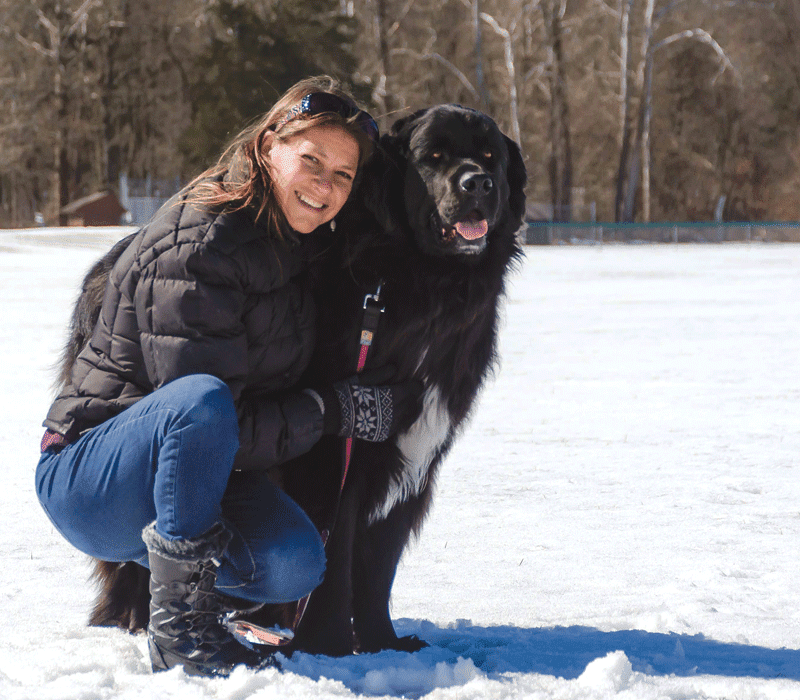Something to Wag About Therapy Dogs Bring Comfort and Warmth to Senior Communities
Karen Demichele recalls a resident at Agawam Healthcare who, toward the end of his life, rarely interacted with visitors. Unless Diamond was around.
“He’d be staring blankly at the ceiling — no reaction,” she recalled. “I said, ‘hi, I’m Karen, and this is Diamond. Do you want to pet her?’ He reached his hand over and started petting her and started having a little grin on his face.”
It wasn’t a one-time thing.
“He wasn’t responding to anyone, but he responded every time we came in,” she said of her visits with her therapy dog. “He said ‘hello,’ he said ‘goodbye,’ he laughed when she put her front paws up on the bed, he reached forward. She really just connected with this guy.”
Another resident, a blind woman, would yell out when she thought she heard Karen and her dog walk in, ‘I know Diamond’s here! Diamond, come see me!’ Demichele recalled, adding that the woman eventually requested a photo of Diamond to hang above her bed to show other visitors, even though she couldn’t view it herself.
“I love seeing the smiles of the people who know her and look forward to seeing her,” she added. “It’s amazing the bond she can make with people who are complete strangers. Wherever you go, people just stop. She just makes everyone smile.”
Demichele trained her dog for her senior-community visits through Bright Spot Therapy Dogs, a Leeds-based nonprofit founded by Cynthia Hinckley in 1994. Dogs from Bright Spot visit hospitals, psychiatric facilities, senior centers, rehabilitation facilities, schools, and, most recently, businesses and even Bradley International Airport.
Research backs up the benefits of dogs in these settings. A study from several years ago suggested a few minutes of stroking a dog reduces the stress hormone cortisol, while a project conducted at Monmouth Medical Center in New Jersey showed patients waiting to have an MRI test found interacting with a therapy dog soothing.
Hinckley first became passionate about the mission when she went into a psychiatric facility with one of her dogs, and a patient who hadn’t spoken in 20 years began to talk.
“The director of the unit was going out of her mind, telling me when we left the room that she had witnessed a miracle, because no one had been able to accomplish what my dog had done in 20 minutes time,” she recalled. “That’s what got me going, and I haven’t stopped since.”
Mood Shift
Tonya Plumb, executive director of the Foundation for TJO Animals, has made many visits to area senior facilities with her dog Lili, and has seen how moods instantly change.
“A lot of times, people were just sad, hanging out, unless they had a visitor, but the minute Lili walked in, it was like the sun came out,” she said. “She brought so much happiness. We had our favorite people, and they looked forward to her so much.”
Maybe it’s their innocence and purity, she noted, but “dogs can do things people can’t.”
Plumb first became interested in being a therapy team with Lili when she read an article about Bright Spot Therapy Dogs and the organization’s work at nursing homes. So she got certified — which is not a quick process. Bright Spot expects dogs to arrive already well-trained and well-mannered, and the dogs that pass a temperament screening undergo a series of training sessions with their owners, culminating with a supervised visit to an assisted-living facility.
“We developed what we feel is a very good process,” Hinckley said, noting that most communities that invite canine visits require certified therapy dogs, for liability reasons.
And more and more centers are booking those visits, she added, noting that Bright Spot has a list of 225 facilities requesting its services.
“In senior-living environments, you often find people who are dog lovers who, as they got older, couldn’t have a dog anymore, so it’s comforting to have one visit. Oftentimes, they had to give up their beloved pet when they had to enter an assisted-living facility, so to these people, it’s a tremendous joy to have a dog come in on a regular basis. For some people, it’s the only visitor they have during the week.”
Demichele visits Agawam Healthcare every Friday, visiting a different floor each week, as well as common areas where a visiting entertainer might be singing or leading residents in an activity.
“I’ll go in and ask who wants to pet her. Usually the entertainment wants to pet her, too. Then I visit a floor and knock on people’s doors. They pet her, and she gives kisses, and we’ll do a couple tricks for them.
“I definitely love how it makes people happy,” she added. “People just light up when they see her walk through the door. When my dog interacts with people, it changes their whole outlook on being in a nursing home; they look forward to it. And she likes being in the spotlight — she’s happy, and she’s wagging her tail, and just seeing people laugh out loud, and seeing how much joy she brings to residents, is just gratifying. For myself, it’s just a positive thing, and I feel good when I can volunteer and make people happy.”
Special Connection
Hinckley still trains plenty of dogs for the healthcare environment, even as she has gotten more personally involved in other settings, such as schools, businesses, and even airports — she has 14 teams visiting Bradley each week, visiting terminals and trying to ease the stress of travel.
Among her most vivid memories is bringing four dogs to Newtown, Conn. after the Sandy Hook massacre in 2012. “A councilman there told me, of all the kindnesses bestowed on the town, those therapy dogs made the most difference.”
So it’s only natural that therapy dogs are becoming more frequent guests in the senior-living setting — a far cry from the early days of Hinckley’s work, when it was difficult to find residences that welcomed dogs. But the sector came around in a big way during the 2000s, she added, and a separate trend over the last decade has been bringing dogs into schools. “I was an educator for many years, and I saw the research studies on the benefits of human-canine interaction that began to open the eyes of those in education.”
Hinckley has trained seven therapy dogs of her own, and her first one, Beatrice, visited senior facilities for nine years. Often, she said, residents’ family members would schedule their visits around when Beatrice would be around. She’s done plenty of work in hospice settings, too, and admitted those visits can be emotionally challenging.
“It takes a very special type of dog to do hospice work,” she told HCN, recalling one dying man who lay with a dog for hours, his hand placed on the dog’s head. “You could see his body relax. Some people were at the point where they couldn’t talk, but a smile came to their face. It was utterly the most moving type of work I’ve ever done.”
Even outside the hospice setting, Plumb said, there’s some sadness when she brings Lili around and learns that one of their favorite people isn’t there anymore. “That’s the tough part. But there’s always someone new to see.”
And chances are, they want to be around a dog, Hinckley said, pausing when asked what makes canines so well-suited for this role.
“Dogs aren’t talking back; they’re simply there,” she finally said. “That’s the difference between a person and a dog. A person feels like they have to talk, but a dog is just there, and the patient can just hug the dog and pet the soft fur. I’ve seen someone in sadness or pain brighten up when the dog comes into the room. To me, it’s just a magical thing to watch, and I feel very privileged to be at the other end of the leash and see that connection.”



Comments are closed.